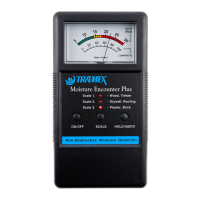19
MEP USER GUIDE
WORKING WITH YOUR MOISTURE ENCOUNTER:
Scale 3
Testing plaster or brick
a. Your Moisture Encounter Plus gives qualitative
(relative) reading on walls, plaster, brick, drywall
and block. Make sure the appropriate wall scale
is used i.e. Scale 2 for drywall and Scale 3 for
plaster or brick. Always press the electrodes
firmly against the surface.
b. The moisture profile of a wall can be determined
by sliding your Moisture Encounter Plus across
the surface where it will read through most
paints, vinyl, wall coverings and even ceramic
tiles.
c. The Moisture Encounter Plus will help identify
the different levels of moisture even if not
apparent on the surface. Moisture can often be
trapped behind drywall and wall covering.
d. Rising damp and moisture migration from leaks
anddefective, or non-existent, vapor barriers can
be identified and profiled and often its source
identified by sliding the instrument across the
wall surface.
e. Water damage following flooding or fire fighting
can be checked and the drying out and de-humidi-
fication process can be monitored.

